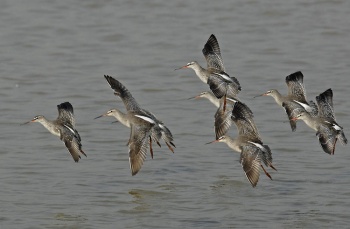m |
(→External Links: New combined GSearch. GSearch checked template) |
||
| (20 intermediate revisions by 9 users not shown) | |||
| Line 1: | Line 1: | ||
| − | {{ | + | [[Image:IMG 0087m.jpg|thumb|550px|right|Breeding plumage<br />Photo © by {{user|Cristian+Mihai|Cristian Mihai}} <br />Comana (Giurgiu), [[Romania]], May 2008]] |
| − | ;Tringa erythropus | + | ;[[:Category:Tringa|Tringa]] erythropus |
| − | [[Image:Spotted_Redshank.jpg|thumb|350px|right|Photo by Andy Bright]] | + | ==Identification== |
| − | == | + | 29-32 cm (11½-12½ in) <br /> |
| − | < | + | Bill: Red lower mandible, with black tip; slightly de-curved<br /> |
| − | + | Red legs<br /> | |
| + | White rump<br /> | ||
| + | [[Image:Spotted_Redshank.jpg|thumb|350px|right|Winter plumage<br />Photo © by {{user|Andy+Bright|Andy Bright}}<br />[[England]]]] | ||
| + | '''Summer Adult''' | ||
| + | *Dark grey to black body | ||
| + | *Upperparts spotted white | ||
| + | '''Winter Adult''' | ||
| + | *Grey-brown above | ||
| + | *White below | ||
| + | *Grey chest | ||
| + | *Marked white [[Topography#Heads|supercilium]]<br /> | ||
| + | '''Juvenile''' similar to the winter adult but much darker. Irregular streaks on flanks | ||
| + | ====Similar Species==== | ||
| + | Can be told from winter-plumaged [[Common Redshank]] by the obvious white supercilium. | ||
| + | ==Distribution== | ||
| + | [[Image:Svartsn ppa copy.jpg|thumb|350px|right|Autumn plumage<br />Photo © by {{user|Digiscoper321|Digiscoper321}}<br />West [[Sweden]], September 2010]] | ||
| + | They breed in [[Siberia]] and winter in Mediterranean [[Europe]] and [[Africa]], [[China]] and South-east [[Asia]]. | ||
| + | ==Taxonomy== | ||
| + | This is a [[Dictionary_M-S#M|monotypic]] species<sup>[[#References|[1]]]</sup>. | ||
| + | ==Habitat== | ||
| + | They breed by pools, marshes and peatbogs. Winters on muddy estuaries. | ||
| + | ==Behaviour== | ||
| + | Feeds in deeper water than Common, lunging at prey and sweeping the bill from side to side. | ||
| + | ====Flight==== | ||
| + | [[Image:spotted_redshank_alok.JPG|thumb|350px|right|Transitional plumage at the end of winter before migration out of [[India]]<br />Photo © by {{user|aloktewari|Alok Tewari}}<br />Gurgaon Rural, Haryana, April-2017]] | ||
| + | Similar to [[Common Redshank]] but legs extend further beyond the tail. | ||
| + | ====Breeding==== | ||
| + | Generally [[Dictionary_M-O#M|monogamous]]. The clutch consists of 4 eggs, which are laid in a ground scrape. | ||
| + | ====Diet==== | ||
| + | The diet consists of fish, insect larvae, shrimps, amphibians and worms. Also terrestrial flying insects | ||
| + | ====Vocalisation==== | ||
| + | {{ Audio|Tringa erythropus (song).mp3 }} | ||
| + | |||
| + | [[Image:1568spotted redshanks land DSC0375.jpg|thumb|350px|right|Photo © by {{user|Neil|Neil}}<br />[[Hong Kong]], [[China]], January 2007]] | ||
| + | ==References== | ||
| + | #{{Ref-Clements6thAug18}}#Collins Pocket Guide to British Birds 1966 | ||
| + | #Collins Field Guide 5th Edition | ||
| + | #Collins Bird Guide ISBN 0 00 219728 6 | ||
| + | #Handbook of the Birds of the World Alive (retrieved Sept 2017) | ||
| + | {{ref}} | ||
==External Links== | ==External Links== | ||
| − | + | {{GSearch|"Tringa erythropus" {{!}} "Spotted Redshank"}} | |
| − | [[Category:Birds]] | + | {{GS-checked}}1 |
| + | <br /> | ||
| + | <br /> | ||
| + | |||
| + | [[Category:Birds]][[Category:Tringa]][[Category:Bird Songs]] | ||
Revision as of 21:00, 22 January 2023
- Tringa erythropus
Identification
29-32 cm (11½-12½ in)
Bill: Red lower mandible, with black tip; slightly de-curved
Red legs
White rump
Summer Adult
- Dark grey to black body
- Upperparts spotted white
Winter Adult
- Grey-brown above
- White below
- Grey chest
- Marked white supercilium
Juvenile similar to the winter adult but much darker. Irregular streaks on flanks
Similar Species
Can be told from winter-plumaged Common Redshank by the obvious white supercilium.
Distribution
They breed in Siberia and winter in Mediterranean Europe and Africa, China and South-east Asia.
Taxonomy
This is a monotypic species[1].
Habitat
They breed by pools, marshes and peatbogs. Winters on muddy estuaries.
Behaviour
Feeds in deeper water than Common, lunging at prey and sweeping the bill from side to side.
Flight

Photo © by Alok Tewari
Gurgaon Rural, Haryana, April-2017
Similar to Common Redshank but legs extend further beyond the tail.
Breeding
Generally monogamous. The clutch consists of 4 eggs, which are laid in a ground scrape.
Diet
The diet consists of fish, insect larvae, shrimps, amphibians and worms. Also terrestrial flying insects
Vocalisation
References
- Clements, J. F., T. S. Schulenberg, M. J. Iliff, D. Roberson, T. A. Fredericks, B. L. Sullivan, and C. L. Wood. 2018. The eBird/Clements checklist of birds of the world: v2018. Downloaded from http://www.birds.cornell.edu/clementschecklist/download/
- Collins Pocket Guide to British Birds 1966
- Collins Field Guide 5th Edition
- Collins Bird Guide ISBN 0 00 219728 6
- Handbook of the Birds of the World Alive (retrieved Sept 2017)
Recommended Citation
- BirdForum Opus contributors. (2025) Spotted Redshank. In: BirdForum, the forum for wild birds and birding. Retrieved 11 May 2025 from https://www.birdforum.net/opus/Spotted_Redshank
External Links
GSearch checked for 2020 platform.1







